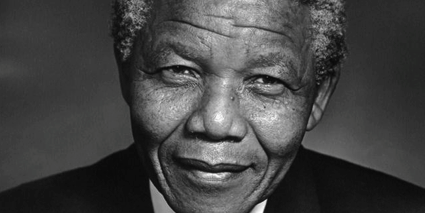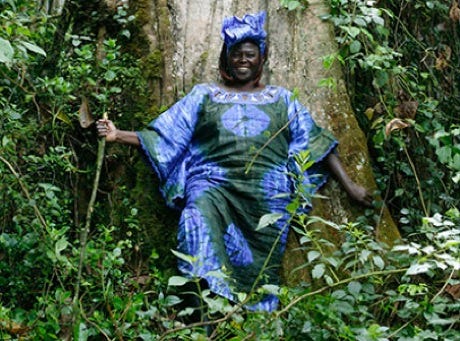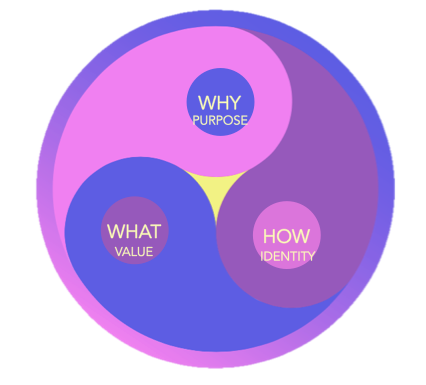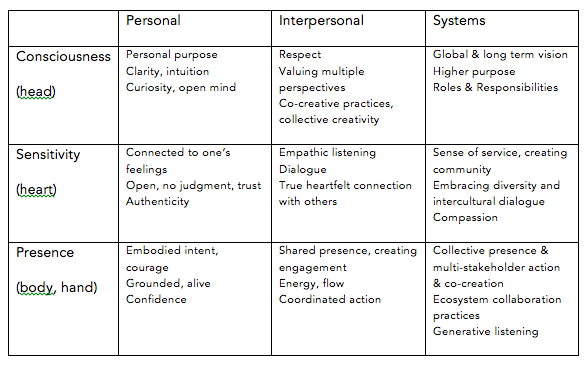By Chris Hoerée and originally published on medium.com
Why is “Leadership” so important today?
In the last few years, many CEO’s, entrepreneurs and coaches have been prototyping new ways of collaborating, new business models, self-managing teams, lean and agile principles, etc. The book of F. Laloux, Reinventing Organizations, O. Scharmer’s Theory U and the many learning communities that emerged have been a catalyst in this movement of organizational innovation for myself and many others.
I was given the unique opportunity to help building an organization based on the principles Laloux described in his book. We implemented an inspiring higher purpose and strong company values, a shift towards an agile innovation culture, where people evolved based on their roles & talents, new co-creative practices integrated in the day-to-day operations. Our biggest challenge was the implementation of the principles of wholeness and self-management. Being able to be your whole self at work requires courage and a conscious authentic self that is not trapped into ego or fear for rejection; hence the need for a safe environment for people and personal development. Self-management asks from people to take individual responsibility and initiative while at the same time working together as a team. It requires high levels of awareness of group dynamics and skills in interpersonal communication and facilitation. These skills are not often part of the business training of professionals and managers. We experienced that for operating an organization based on Teal or similar principles, a new organizational culture, and as a consequence, a new leadership culture has to be established.
Reinventing Organizations means Reinventing Leadership.
I saw my observation confirmed in the 2016 Global Human Capital Trends report of Deloitte University Press among 7000 business and HR leaders in 130 countries: “Leadership for a new kind of organization” was the top of mind concern of business & HR leaders globally in 2016. As companies have to be more agile and customer-focused, they are shifting from traditional, functional structures to interconnected, flexible teams. A new organizational model is on the rise: a “network of teams” in which companies build and empower teams to work on specific business projects and challenges. These networks are aligned and coordinated with operations and information centers. In some ways, businesses are becoming more like movie production teams, with people coming together to tackle projects, then moving on to new assignments once the project is complete. This new structure has important implications for leadership development.
89% of executives in the survey rated the need to strengthen, reengineer, and improve organizational leadership as an important priority. 56% of executives report their companies are not ready to meet leadership needs.
Although the acknowledgement of WHY Leadership is hyper-relevant today, there are a myriad of answers on the questions WHAT leadership is.
What is Leadership? — The origin of the word
In order to touch on the essence of the meaning of a word, it is often useful to go back to its roots, its etymology. The root words of “leading” can be found in Indo-European and Germanic languages: the Indo-European root word “leit(h)” means to go forth, to cross a threshold, to leave, to die; the Old English “lædan” means march at the head of, go before as a guide, accompany and show the way, carry on, pass (one’s life); the root word “liðan” means to travel, to go forth (from Proto-Germanic laidjan). Interestingly, there is a clear difference in the root of the words “lead“ and “manage”: manage is derived from the Latin root word “manus”, what means “hand”. There is a clear connection between managing and handling or controlling things. The word “lead” comes from several root words meaning “to go (forth)”.
“Leading” is about crossing a threshold, going places never seen before, and then, going forth, guiding, showing the way.

The roots of the word leadership essentially talk about a “process”: a personal process (a journey towards consciousness) as well as a collective process (to show the way to others). Travelling, crossing a threshold is the first step in the Hero’s journey, according to Joseph Campbell. Facing the unknown with openness and trust, receiving what is emerging is part of the hero’s quest. But there is also a social level: the hero returning to society, transformed, reborn, is sharing his/her knowledge, showing the way, guiding others to new places never seen before. While “managing” is about handling, command and control, “leading” is about a process of learning and transformation that starts with a personal journey of growth in consciousness.
What is Leadership? — Leadership models & their qualifiers
Leadership as such is open and can serve the good or the bad.
Leadership needs a qualifier to embed it in a time and ethical context. The qualifier shows the belief system from which you operate.
“Trait Leadership” for example, is based on the assumption that (innate) personal characteristics are responsible for leader effectiveness independent of the situation. The underlying belief is that a universally agreed list of leadership qualities exists.
“Situational Leadership” on the other side, believes that effective leadership is task-relevant; the most successful leaders are those who adapt their leadership style to the abilities of the individual or group in front of them. The assumption here is that leaders can change their behavior at will to meet different circumstances. It neglects the impact of unconscious beliefs, fears and habits, with other words the human psychology.
“Transformational leadership” is a concept of leadership assuming that a leader works together with others to identify needed change and create an inspiring vision to guide and execute the change. A transformational leader enhances the motivation and performance of the people he/she is leading by connecting their sense of identity and self to a project and to the collective identity of the organization. Transformational leaders are role models and have the ability to inspire others based on their charisma and vision. This model implies a strong presence and personal leadership and strong interpersonal skills, but it does not necessarily imply shared or co-leadership.
The “Primal Leadership” model of Goleman, author of “Emotional Intelligence”, is based on a lot of studies showing that emotional competencies like self-awareness, authenticity, empathy, service attitude, collaboration skills, have an enormous impact on the effectiveness of leadership.
It is not the purpose here to list all current leadership models (generative, integral, servant, etc.). Most models recognize the following elements as key to leadership: strong inner leadership and presence, vision, engagement, emotional intelligence and action. To me, this would apply to somebody like Wangari Maathai, the woman who started the Green Belt Movement and won the 2004 Nobel Peace Prize.

eCo Leadership — leadership for a sustainable positive future
I said before that the “qualifier” going with the word leadership shows the values and beliefs that are underlying the leadership model. For me, this time and ethical context in which the needed leadership is embedded, is the following:
The challenge of today, on the level of the individual, the organizations as well as socio-economic systems, is to co-create a sustainable positive future for all participants and the planet we are living on, using our individual and collective intelligence and creativity and combining technological innovation with universal wisdom.
This requires a multi-layered concept of leadership:
1. The basis, on the individual level, is Presence and Leadership Consciousness: the individual leader will have to go on his/her own quest, finding answers on the universal questions: who am I, where do I come from, where do I go to? I have called this the personal Why-How-What, the discovery of your personal purpose, identity and contribution to the world. This process is necessary if we want to move from an ego to an eco-awareness, from organizations that are like machines towards organizations that are like living systems. A personal quest results in renewed inner strength and embodied consciousness, a certain easiness, flow and vibrant presence. The most important in this process is to let go of fear and doubts, attachment to old patterns and distraction.
It takes a lifetime but start with the first step. The first step is this crossing the threshold, then, confidently going forth, acting with courage and responsibility.
2. On the relational and organization level, the leadership that is needed to lead ecosystems or networks of teams rather than traditional hierarchical companies, is Co-leadership.
Shared/distributed/rotating/collective leadership acknowledges peer influence and engages in consultation and coordinated action. Co-leadership is more a relational or group process than a position and assumes interpersonal influence, dialogue and mutuality. A Co-leadership team is operating based on roles rather than positions. It requires an in-depth understanding of systemic patterns and dynamics from the members. In a living system, everyone and everything has to have its place, and even though there is no hierarchy in the traditional pyramidal way, there is always an invisible order or archetypal structure within a system. This invisible order and its consequent dynamics can be healthy and natural or can be unhealthy and unproductive. They need to be brought to consciousness in the team in order to make necessary changes and transformations. The leadership team has to build its unique tribal order — are we a herd of horses, a wolf pack, a flock of geese? — and distribute roles and responsibilities on the more day-to-day pragmatic level. This type of work asks for trust, open dialogue and authenticity in a group. Co-leadership therefor requires strong interpersonal skills from members, specifically non-violent communication and conflict handling skills, and the ability to facilitate open conversation and co-creation.
3. On a bigger picture level, in the social and economic field, leadership will have to deal with increased complexity, “chaordic” principles and organic and disruptive change: simultaneous top-down, bottom-up, diagonal, and circular change processes. Partnering, co-creation and open innovation across organizational and/or sectorial boundaries will be desirable and necessary. Leading eco-systems will become the new norm. The required skills and knowledge of leadership teams working with living systems and transformation processes is a combination of new technology, fresh and fluid innovative thinking and a deep and intuitive understanding of natural and human processes.
Paradoxically enough all this complexity is in our nature as humans, it is in nature and life itself and readily accessible as a source of intelligence and wisdom. Our biggest challenge is to unlearn old habits and (re-)discover, learn and adopt new practices of communicating and collaborating.
Therefor, the qualifier for the leadership concept described here is “eCo Leadership”. eCo refers to:
– Leadership Consciousness
– Co-leadership
– Leading eco-systems
– Nature and natural wisdom
Hence, I propose the following definition of eCo Leadership:
“eCo Leadership is the ability of a group of individuals by their presence, creativity and wisdom to inspire others to co-create the purpose of an organization (company, non-profit, community,…).”
For me, the 7 ingredients of eCo Leadership are the following (ingredients can be qualities, skills and practices that can be developed by individuals and teams and are characteristic of an eCo Leadership culture):
1. Consciousness
2. Presence & Personal Leadership
3. Higher Purpose
4. Interpersonal Sensitivity
5. Curiosity, creativity
6. Courage & Action
7. Engaging others & creating community
Now that I have established the qualifier and underlying belief system, definition and characteristics of eCo Leadership, I will give a framework for the “How” without going into details since every Leadership coach applying it, will have his/her own style and approach.
HOW to develop eCo Leadership? — a framework
The 7 leadership ingredients I mentioned before will have to be developed at three levels: personal, interpersonal, and on the level of organizations and eco-system.
I believe that Leadership development has to start from the inside out. A personal quest for attaining or refreshing Leadership Consciousness will be the first step. The model I developed as guidance and structure for this quest is the “Personal Why-How-What”. Although this is a process of self-discovery, it is best experienced in both individual as well as interpersonal learning. This is why I favor a retreat format. Individual mentoring can be part of this and/or follow the retreat. The methods used in this phase can be: mindful meditation, nature walks and conversations, visualization, shamanic journeying, intuitive writing & drawing, circle talks, systemic constellations, deep listening & dialogue, action & reflection, prototyping…

The result of the process is to get clarity on your personal purpose, on your heart’s fire, on what drives you and gives your real meaning to your life and work.
You will rediscover your true identity, your talents, your essence, what gives you energy and joy. You will become more conscious about your unique way of being, perceiving and interacting, your patterns and style as a leader. You will explore your place in a group, your qualities and pitfalls in a co-leadership role. You will explore and crystallize your Work in the world: what you want to contribute, create, realize.
The next levels of continued learning are on the interpersonal and organizational level, this means, it is developing eCo Leadership skills and practices like participative methods, holding the space for others, facilitating deeper levels of listening and conversation, facilitating circle ways, etc. … This can be done in subsequent open retreats or in-company training with specific Leadership teams can.
Inspired on Integral leadership concepts and the ideas brought forward by O. Scharmer, I propose the following framework for developing eCo Leadership qualities & practices.
It takes into consideration the 3 layers of leadership: personal, interpersonal and systems (organizational + ecosystems) levels and 3 important facets of human psychology: “Consciousness” including intuition and mind, “Sensitivity” including emotional intelligence and compassion and “Presence” including intent and action.

In my work with Leadership teams, my experience has been that learning to recognize the level of listening and conversation is an eye-opener for people: the shift from downloading to empathic and generative listening, from debate to dialogue is a radical change in culture. Practicing new ways of listening and conversing changes the culture in a leadership team. I often experienced in my work with management teams, that a talking circle gave people energy although it would take a lot more time than the many rushed business meetings that leaders sit in all day. Sometimes, “slower” practices as circle ways are felt to be inappropriate for the day-to-day business, where an often artificial sense of speed rules. But once a leadership team is familiar with these new methods and recognizes the value of it, the spirit of these methods can be integrated in a creative way in day-to-day practices.
Circle talks are a very accessible way to start re-learning to listen to each other, to utilize silence and space in the conversation, to move from exhausting debates to authentic open dialogues.
The conscious implementation of new “practices” is an important part of changing the culture of an organization. Practices are new habits, habits are the cornerstones of a culture.
An obstacle for establishing a new culture of listening and conversation often is the physical environment: hi-tech meeting rooms where it is impossible to move the tables out and make the simplest and most natural of geometries: a circle.
Conclusion
In the last couple of years, Laloux’s Reinventing Organizations, Theory U and the U-Labs of O. Scharmer, the Teal and Integral movements, Enlivening Edge community and our local Community of Practice (2BeLinked) were for me and many others, a catalyst and accelerator for change. Although all these ideas as such were not “new-new”, the momentum was created to make them the “new normal”. Suddenly a true higher purpose had its place in the business world. Coaches, entrepreneurs, CEO’s, professionals from all sectors and backgrounds courageously started prototyping new ways of collaborating, operating with new business models, self-managing teams, circle ways …
My personal quest was an intensive integration of skills and experiences from very different fields of life. I could deploy intuitive practices that before were not heard of or talked about in the business world.
My personal purpose is to contribute to a sustainable positive future for the generations to come, for life and the planet by developing the leadership capacity and collective wisdom needed for that, by helping people to unfold their untapped abilities and creativity and supporting the co-creating of ecosystems in a new economic paradigm.
Featured Image/graphic link added by Enlivening Edge Magazine




